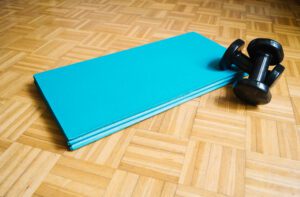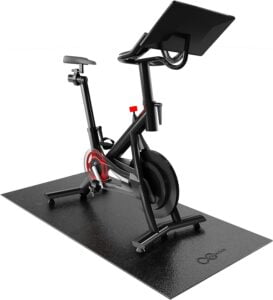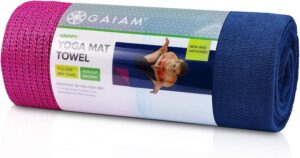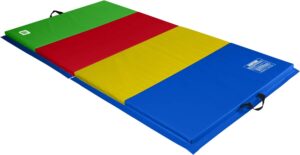
Looking to enhance your home workout experience? Workout mats are the unsung heroes of any exercise routine, providing comfort, support, and stability. Whether you’re into yoga, Pilates, or high-intensity interval training (HIIT), a quality workout mat is essential for maximizing your performance and minimizing the risk of injury. Stay tuned for expert tips on choosing the perfect yoga mat tailored to your specific fitness needs.
Exploring Workout Mats
Types Available
Workout mats come in various types to cater to different exercise needs, gym, floor exercises, and cell foam products. Yoga mats are ideal for yoga and stretching routines, offering sufficient cushioning and traction. Exercise mats provide a versatile option for general workouts, featuring foam material and floor durability. On the other hand, multi-purpose gym mats serve as all-around solutions for diverse exercises, including bodyweight workouts and light cardio.
Some specialty options like Pilates mats offer specific features tailored to Pilates exercises, such as enhanced support and stability. High-density foam mats are suitable for intense activities like HIIT (High-Intensity Interval Training) at the gym due to their robust construction. For those environmentally conscious individuals, there are eco-friendly choices available such as natural rubber or cork mats.
Home vs Gym Use
When selecting gym workout mats for home use, it’s essential to consider portability and storage convenience. A foldable or roll-up mat can be advantageous for easy transport and compact storage in limited spaces. Moreover, personalized mat selection based on individual preferences is possible at home.
In contrast, gym-use workout mats should prioritize durability, waterproofing, and easy cleaning due to higher traffic volumes compared to home settings. These durable pilates and yoga mats ensure longevity despite frequent use by multiple individuals during classes or open gym sessions.
Key Features
Traction
Traction is a key feature of foam workout mats that significantly impacts safety during exercises. Non-slip surfaces prevent injuries by providing stable footing throughout the workout session. Textured surfaces such as yoga mats contribute to better grip during movements such as lunges or planks while maintaining stability during high-intensity workouts like jump squats or burpees.
Durability

The durability of workout mats is crucial in maintaining support and cushioning over time with regular use. High-quality waterproof materials like PVC (Polyvinyl Chloride) or TPE (Thermoplastic Elastomer) ensure long-lasting performance even after prolonged usage in both home gyms and commercial fitness facilities.
Comfort
Enhanced comfort during floor exercises is achievable with thicker workout mats that provide ample cushioning underfoot while performing various movements ranging from yoga poses to core strengthening exercises. Soft foam materials used in some mat constructions deliver added comfort benefits particularly beneficial during extended yoga or stretching sessions.
Benefits of Workout Mats
Protecting Joints
Workout mats, with their thick and cushioned surfaces, play a crucial role in protecting the joints during exercises. These foam mats help reduce the impact on joints, making them especially beneficial for individuals with arthritis or joint pain. For example, when performing activities like jumping jacks or lunges, the shock absorption provided by these mats can significantly reduce strain on the knees and wrists. This is essential for maintaining joint health and preventing injuries during workouts.

Workout mats made of foam offer proper support that can prevent overextension of joints while exercising. This is particularly important for exercises that involve putting pressure on specific areas of the body such as push-ups or planks. By providing a softer surface to work on, workout mats contribute to minimizing discomfort and potential injury caused by repetitive movements.
Enhancing Workouts
The use of workout mats extends beyond just providing a comfortable surface; they also enhance the overall quality of workouts. For instance, during balance-focused exercises like yoga or Pilates, these mats provide stability that helps practitioners maintain their poses without slipping or sliding. The enhanced grip offered by these mats ensures better traction and stability while performing various poses and movements.
Moreover, foam workout mats aid in maintaining proper form and alignment throughout different exercises. They act as a visual guide for positioning feet and hands correctly during workouts such as push-ups or lunges. By having a designated space marked out by the mat’s boundaries, individuals can ensure consistency in their posture which contributes to more effective workouts.
Floor Protection
In addition to supporting exercise routines, workout mats serve an essential purpose in safeguarding flooring surfaces within home gyms or fitness spaces from damage caused by heavy equipment usage. Hardwood floors are prone to scratches and dents resulting from repeated placement of weights or exercise machines; however, placing durable workout mats underneath this equipment acts as a protective barrier against such damage.

Furthermore, sweat accumulation during intense workouts can pose risks to flooring materials like hardwood or carpeting due to moisture absorption which may lead to staining or warping over time. Utilizing workout mats effectively prevents this issue by creating an impermeable layer between sweat-producing activities and vulnerable flooring surfaces.
Workout Mat Buying Guide
Thickness Guide
When choosing a workout mat, it’s essential to consider the thickness. Thicker mats, typically 1/4 inch or more, are ideal for providing superior cushioning and support for joints during high-impact exercises like jumping jacks or burpees. On the other hand, thinner mats, around 1/8 inch thick, offer a firmer surface that is perfect for balance-focused exercises such as yoga or Pilates. For instance, when performing Pilates exercises that involve intricate movements and controlled breathing techniques, a thinner mat provides the necessary stability without compromising comfort.
It’s crucial to take into account the type of exercises you primarily engage in when selecting the thickness of your workout mat. For activities that require more cushioning and support for joints, opting for a thicker mat would be beneficial. Conversely, if your workouts focus on balance and stability training like Pilates or yoga poses where firmness is key to maintaining proper form, then a thinner mat would be more suitable.
Size Considerations
Standard workout mat sizes generally range from 68 to 72 inches in length and 24 to 26 inches in width. However, individuals with larger body frames may find these standard sizes insufficient for adequate coverage during their workouts. In such cases, considering extra-long or wide mats would ensure full body support while exercising.
For example: A taller individual practicing yoga might need an extra-long mat to comfortably perform poses without feeling restricted by limited space on the mat surface. Additionally, it’s important to factor in both storage availability and exercise space. A large workout mat might not fit well in smaller living spaces, so measuring available room dimensions before purchasing is crucial. By taking into account both personal dimensions and available exercise areas, individuals can select an appropriate size that meets their specific needs.
Comparing Exercise Mats
Yoga vs Exercise Mats
Yoga mats are designed to be thin and provide excellent stability for standing poses. They offer a firm grip on the floor, making them ideal for yoga practice. On the other hand, exercise mats are thicker and provide more cushioning, which is suitable for various floor-based workouts like sit-ups, push-ups, or any routine that involves lying down.
When choosing between yoga and exercise mats, it’s crucial to consider your specific workout needs. If you primarily engage in standing poses or balance exercises, a yoga mat would be more appropriate due to its stability. However, if your routines involve floor-based exercises that require extra support and cushioning, an exercise mat is the better choice.
Best Mats for Needs
Versatility
Multi-purpose mats are incredibly versatile as they can accommodate different types of workouts such as yoga, Pilates, strength training, or even high-intensity interval training (HIIT). These mats offer the benefit of serving multiple fitness purposes without needing separate mats for each type of workout.
For instance:
A multi-purpose mat can serve as a comfortable surface for stretching before a workout.
It can also provide a supportive base for meditation practices after an intense session.
The versatility of these mats makes them convenient for individuals with diverse fitness routines who want to streamline their equipment.
Multi-Purpose Use
The convenience of multi-purpose use cannot be overstated. Having one mat that caters to various fitness activities eliminates the need to switch between different ones based on the workout being performed. This not only saves time but also ensures consistency in comfort and support across all exercises.
Importance of Workout Mat Thickness
The thickness plays a crucial role in determining the comfort level during exercise. Thicker mats, usually around 1/2 inch or more, provide a soft and cushioned surface that offers extra support and comfort for various exercises. For instance, when performing floor exercises like sit-ups or planks, a thicker mat can help reduce pressure on the body’s joints and bones.
Moreover, thick workout mats are particularly beneficial for balance-focused activities such as yoga or Pilates. These exercises require stability and support for proper form and alignment. A thicker mat helps create a stable base, allowing individuals to maintain their balance while holding poses or engaging in movements that demand core strength.
In addition to providing physical comfort during workouts, thicker mats also offer psychological reassurance by creating a sense of security and stability underfoot. This can be especially important for those who are new to exercising or practicing challenging poses where confidence in one’s foundation is essential.
Size Matters in Workout Mats
When selecting a workout mat, it’s crucial to consider the available space for both storage and exercise. If you have limited room, opting for a smaller-sized mat might be more practical. A compact mat can be easily stored away when not in use, making it ideal for those with space constraints. On the other hand, if you have ample space and prefer a larger area to move around during workouts, a bigger mat would be more suitable.
Moreover, versatile mats can also serve as a comfortable surface for stretching or meditation practices. For instance, if you enjoy yoga or Pilates in addition to your regular workout routine, having a spacious workout mat will allow you to perform various exercises without feeling restricted by limited space. This versatility adds value to your purchase by providing functionality beyond just serving as an exercise mat.
Maintenance and Care Tips
Cleaning Your Mat
Keeping them clean is essential for maintaining hygiene. Regularly wipe down the mat with a mild soap and water solution to remove sweat, dirt, and bacteria. After cleaning, ensure the mat is thoroughly dried before rolling or storing it. This simple routine can prevent the buildup of unpleasant odors and extend the lifespan of your workout mat.

Using disinfectant sprays or wipes specifically designed for exercise equipment can also help eliminate germs from your workout mat. However, always check the manufacturer’s guidelines to ensure compatibility with your particular type of mat material. Avoid using harsh chemicals that could damage or degrade the surface of the mat.
Investing in a machine-washable workout mat can make maintenance even more convenient. These mats are designed to withstand regular washing without compromising their quality or performance. By following these cleaning practices, you can ensure that your workout space remains sanitary and inviting for every use.
Longevity Practices
The durability of a workout mat is closely linked to its longevity under regular use conditions in gyms or fitness studios. When selecting a gym-specific workout mat, prioritize materials known for their resilience against heavy foot traffic, equipment abrasion, and frequent cleaning routines.
Consider how often you plan to use the workout mats when assessing their durability over time. Mats made from high-density PVC offer exceptional longevity while providing cushioning support during workouts such as yoga or pilates classes where participants spend extended periods on the floor.
Another practical approach to extending the life of your gym-use workout mats involves rotating them regularly within high-traffic areas like weightlifting stations or cardio zones where they receive consistent wear and tear.
The Value Proposition
Cost vs Benefits
When considering workout mats, it’s essential to weigh the cost against the benefits they offer. While some may view workout mats as an additional expense, their benefits often outweigh their initial cost. For instance, investing in a high-quality workout mat can provide long-term protection for both your body and your floors during exercise routines.
Workout mats also offer a layer of cushioning that reduces the impact on joints and muscles during workouts, preventing potential injuries or discomfort. This is particularly advantageous when engaging in activities like yoga, Pilates, or high-intensity interval training (HIIT). Furthermore, these mats create a non-slip surface that enhances stability and balance while performing various exercises.
In addition to these physical benefits, workout mats contribute to maintaining hygiene by providing a barrier between sweat and the floor. This not only keeps your exercise area clean but also extends the lifespan of your flooring material by preventing damage from moisture and friction caused by vigorous movements.
Are Mats Worth It?
Considering the numerous advantages they offer, workout mats are undoubtedly worth the investment for anyone committed to regular exercise routines at home or in fitness facilities. By providing support for joints and muscles, reducing slippage risks, and maintaining cleanliness within workout spaces, these mats play a crucial role in enhancing safety and comfort during physical activities.
Moreover, incorporating workout mats into fitness regimens aligns with responsible maintenance practices for both personal health and property care. These multifaceted benefits make them an indispensable asset for individuals pursuing diverse forms of exercise – from strength training to flexibility-focused workouts like stretching or yoga sessions.
Choosing the Right Mat
Purpose Understanding
Understanding their purpose is crucial. Whether for yoga, Pilates, or general exercise, the mat’s thickness and material are essential. For example, a thicker mat provides more cushioning for joint support during yoga or stretching exercises. Thinner mats are suitable for activities like high-intensity interval training (HIIT) or strength training.
It’s important to consider the type of exercises you’ll be doing on the mat. A folding mat can be convenient if you need to store it away after your workout sessions. Different materials offer various benefits; PVC mats are durable and easy to clean, while natural rubber mats provide excellent grip and are eco-friendly.
Features to Look For
Mat material plays a significant role in choosing the right workout mat. Mats made from TPE (thermoplastic elastomer) offer both durability and eco-friendliness as they are recyclable and biodegradable. The texture of the mat should also be considered; a textured surface enhances traction during sweaty workouts.
When assessing comfort, look for a great choice that offers adequate cushioning without being too soft or too firm. This ensures proper support for your body while performing floor exercises such as sit-ups or planks. Moreover, some mats come with alignment marks that help users maintain proper posture during yoga poses.
Traction Importance
The importance of traction in a workout mat cannot be overstated as it directly affects stability during exercises like downward dog in yoga or mountain climbers in HIIT workouts. A good quality mat should provide ample grip even when sweating profusely during intense routines.
To enhance traction, look for features such as non-slip surfaces or double-sided textures that prevent slipping on smooth floors. Some advanced options even incorporate antimicrobial properties to prevent odor buildup over time due to sweat absorption.
Comfort Assessment
Comfort assessment involves finding a balance between cushioning and firmness based on personal preference and exercise requirements. A foldable design can make storage easier while ensuring portability if you prefer working out at different locations. Some individuals may prioritize an easy-to-clean surface when considering comfort since hygiene is crucial when using shared gym spaces.
Summary
The exploration of workout mats revealed their numerous benefits, from providing cushioning and support to enhancing stability during exercises. The buying guide and comparison of exercise mats emphasized the importance of thickness and size in choosing the right one. Maintenance and care tips were also highlighted to ensure the longevity of workout mats. The value proposition was clear: investing in a suitable workout mat is essential for a safe and effective fitness routine. With all these factors in mind, choosing the right mat becomes a crucial decision for fitness enthusiasts.
For those seeking to elevate their workout experience, applying these insights when selecting a workout mat is paramount. Whether it’s for yoga, Pilates, or other exercises, the right mat can make a significant difference in comfort and performance. Making an informed decision based on the factors discussed will undoubtedly lead to a more rewarding and enjoyable fitness journey.
Frequently Asked Questions
What are the benefits of using workout mats?
Using workout mats provides cushioning for joints, prevents slipping during exercises, protects floors from damage, and defines your personal exercise space. They can absorb impact and noise while also providing insulation against cold floors.
How do I choose the right workout mat thickness?
The right mat thickness depends on the type of exercises you perform. For yoga or Pilates, a thinner mat may be sufficient; however, for high-impact activities like HIIT or weightlifting, opt for a thicker mat to provide better support and cushioning.
What size workout mat should I get?
Consider both your body size and the range of movements you’ll perform. A standard yoga mat is about 68 inches long by 24 inches wide; however, if you’re taller or need more space for dynamic moves, consider a longer or wider option.
How should I maintain and care for my workout mat?
Regularly clean your workout mat with mild soap and water or a specialized cleaner designed for fitness equipment. Make sure to let the workout mat air dry completely before you roll it up. Avoid prolonged exposure to direct sunlight as this can cause damage over time.
Why is comparing exercise mats and gym flooring important before making a purchase?
Comparing exercise mats allows you to assess factors such as material quality, durability, grip level, ease of cleaning/maintenance, portability/storage options, and specific features related to different types of workouts (e.g., extra padding for joint support). This helps in making an informed decision based on individual needs.



Leave a Reply